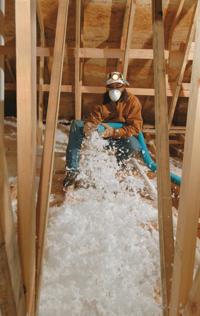Q: If I have insulation blown into my attic, what is the recommended amount I need to have?
A: Anywhere below the Mogollon Rim in Arizona, you need to reach at least the R-30 level of insulation in your attic. You can put in a little more fill to reach the R-38 level — which would be slightly better for energy efficiency. But if an insulation contractor wants to blow in R-40 to R-60, the additional fill needed will not be much more of a benefit in Central or Southern Arizona. The extra cost will not provide you with great savings in your heating and cooling bills.
Make sure the insulation is properly and evenly installed in your attic. If there are any voids in the thickness of the fill, you could have serious reductions in the efficiency of your insulation.
The higher the R-value, the greater the insulation’s effectiveness. The R-value depends on the type of insulation, its thickness and density.
Q: I live in Tucson but have a second home in Show Low. It’s a two-story unit that’s half of a duplex. Recently, we found a crack in the slab near a brick wall. The crack is about 3/8ths to a half-inch wide, about 6 to 8 inches away from the brick wall. It runs all the way across the slab and into the other unit. Can this crack be fixed?
A: Yes, it can be fixed, but you should find out what’s causing the crack. It might even be that the slab is heaving up due to clay soils under the duplex.
You and your neighbor need to have a footprint done for the entire building with a manometer; an engineer needs to look at the results as well. Although the test will cost about $650, perhaps you and your neighbor could split the expense.
Q: I have a gas clothes dryer that was having a problem drying clothes – possibly because lint was building up in the unit and the vent. We tried to clean out the vent tube in the wall and filled up an entire shop vacuum with the lint debris. But then my husband went up on the roof to clean out the vent opening up there, but he couldn’t find the outdoor end of the vent. Where in the world is it?
A: It’s possible that your dryer vent ends up in your attic somewhere. It’s against code to do that when you install a dryer. But workers take that dubious shortcut all the time.
It might be hard to find in your attic — especially if the roof is really low and there is very little space to move around.
One trick you can try is putting some flour in the bottom of the vent and then blowing it up into the attic so you can see where the vent empties out. However, the vent may also exit through an opening in the exterior wall. So look around for a louvered vent or other type of exterior wall vent.
If the vent is truly in the attic, you might consider having it moved so it exits on the roof.
Q: I replaced my windows in the early 1990s with dual-pane windows that are still under warranty. The windows have argon gas between the panes and vinyl on the outside of the frames. Now the putty and vinyl are starting to disintegrate. What should I do?
A: Contact the manufacturer to see if they’ll live up to their warranty. However, I have to add that vinyl windows are not a favorite of mine for use in our desert climate.
My preference is wood with aluminum cladding on the outside. Vinyl windows have improved greatly over the years, however, and the latest models may perform more efficiently than those manufactured 10 to 20 years ago.





